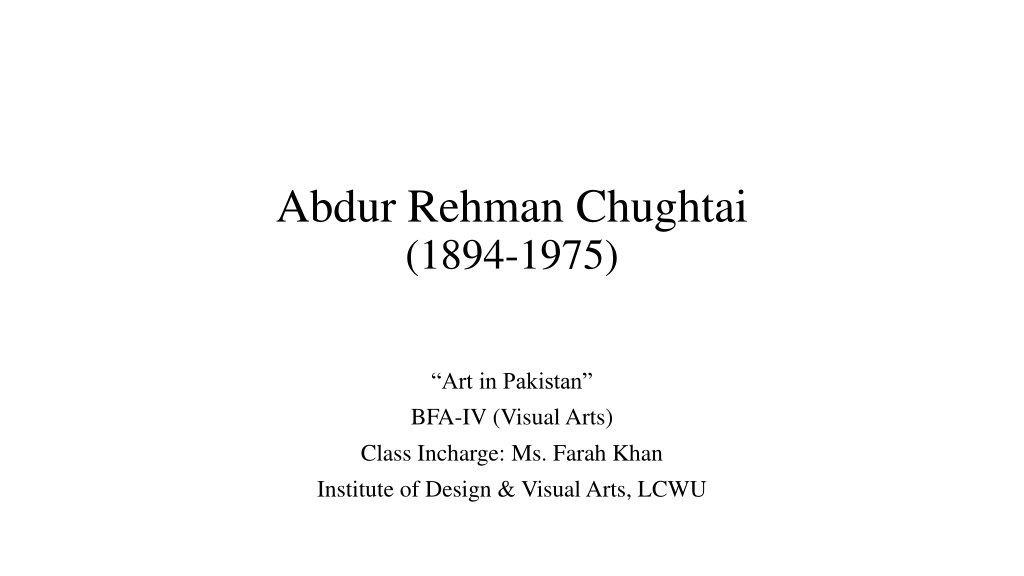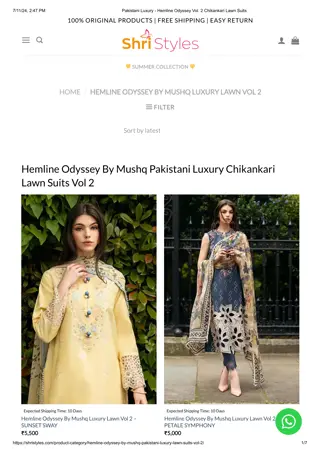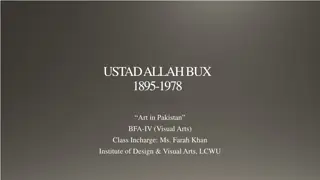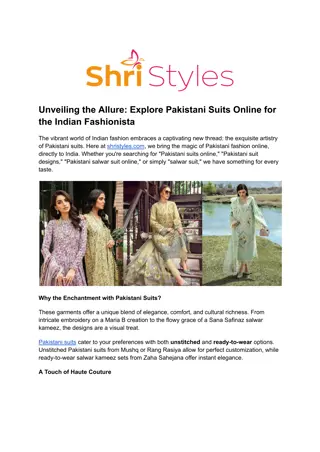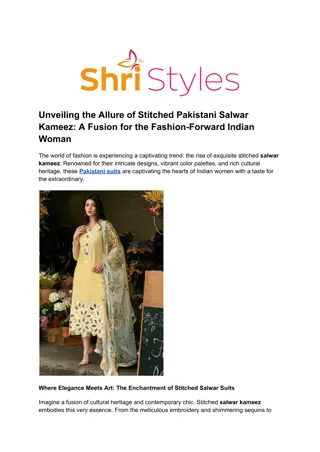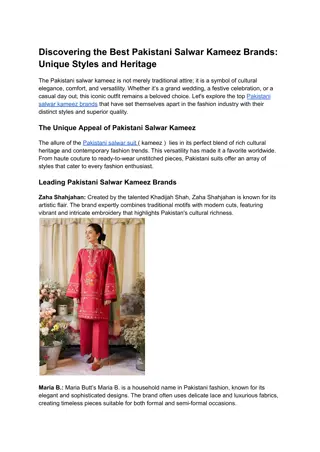Life and Legacy of Abdur Rehman Chughtai: A Pioneer in Pakistani Art
Abdur Rehman Chughtai (1894-1975) was a celebrated painter and intellectual from Pakistan, known for his unique fusion of Mughal art, miniature painting, Art Nouveau, and Islamic art traditions. His contributions to modern South Asian art were groundbreaking, earning him titles and awards for his exemplary work. Chughtai's rich artistic legacy includes thousands of watercolors, sketches, etchings, and literary works that continue to inspire and influence the art scene in Pakistan and beyond.
Download Presentation

Please find below an Image/Link to download the presentation.
The content on the website is provided AS IS for your information and personal use only. It may not be sold, licensed, or shared on other websites without obtaining consent from the author. Download presentation by click this link. If you encounter any issues during the download, it is possible that the publisher has removed the file from their server.
E N D
Presentation Transcript
Abdur Rehman Chughtai (1894-1975) Art in Pakistan BFA-IV (Visual Arts) Class Incharge: Ms. Farah Khan Institute of Design & Visual Arts, LCWU
The only aim of art is that life should thrive. My art is living and will continue to throb with life, so that the land that gave me birth, will be truly immortal . (Abdur Rehman Chughtai) (S. Kashmira Singh, Chughtai's Indian Paintings, Dhoomi Mal Dharam Das, New Delhi, 1951, p. 7) It is a fact that when I began my career in art modern Indian painting was known as the Bengal School...My artistic inclination and views were radically different. My style and subject matter was different...Without any propaganda or outside help my painting changed the direction of that stream which had been dominating the subcontinent art scene . (Abdur Rehman Chughtai)
Abdur Rehman Chughtai Abdur Rahman Chughtai was a painter and intellectual from Pakistan, who created his own unique, distinctive painting style influenced by Mughal art, miniature painting, Art Nouveau and Islamic art traditions. He is considered the first significant modern Muslim artist from South Asia, and the national artist of Pakistan. He was given the title of Khan Bahadur in 1934, awarded Pakistan s Hilal-i-Imtiaz in 1960, and the Presidential medal for Pride of Performance in 1968. He was born in Lahore in 1897 in the area known as Mohalla Chabuk Sawaran , the second son of Karim Bukhsh, in a family descended from generations of craftsmen, architects, and decorators. He briefly learnt naqqashi from his uncle Baba Miran Shah Naqqash at a local mosque. After completing his education at the Railway Technical School, Lahore. In 1911, He joined the Mayo School of Art, where Samarendranath Gupta, a pupil of Abanindranath Tagore was Vice-Principal. After leaving the school, he made a living for a while as a photographer and drawing teacher. He eventually became the head instructor in chromo-lithography at the Mayo School.
Abdur Rehman Chughtai In 1916, Chughtai s first painting in a revivalist oriental style appeared in the Modern Review. He had his first exhibition in 1920 at the Punjab Fine Art Society. He also exhibited with the Indian School of Oriental Art during the 1920s, by which time he had become quite renowned. His work contributed greatly to Lahore s burgeoning modern art scene. Whilst he predominantly worked with watercolors, Chughtai was also a print- maker, perfecting his etching skills in London during visits in the mid 1930s. In his sixty years of artistic creation, Chughtai produced nearly 2000 watercolors, thousands of pencil sketches, and nearly 300 etchings and aquatints. He also wrote short stories, and articles on art. He designed stamps, coins, insignia and book covers. He was also an avid collector of miniatures and other art. He published three books of his own work: the Muraqqai-i-Chughtai (1928), Naqsh-i-Chughtai (c. 1935) and Chughtai s Paintings (1940). The Muraqqa-i-Chughtai was a sumptuously illustrated edition of Mirza Ghalib's Urdu poetry, with a foreword by Sir Muhammad Iqbal. It is regarded as the most significant work of Chughtai s career and in its time, was considered the finest achievement in book production in the country.
Abdur Rehman Chughtai Chughtai s early watercolors take from the revivalism of the Bengal School - his Jahanara and the Taj, for instance, show the influence of Abanindranath Tagore s painting The Last Moments of Shah Jahan. By the 1940s he had created his own style, strongly influenced by Islamic art traditions, but retaining a feel of Art Nouveau. His subject matter was drawn from the legends, folklore and history of the Indo-Islamic world, as well as Punjab, Persia and the world of the Mughals. After the creation of Pakistan in 1947, Chughtai came to be regarded as one of the most famous representatives of Pakistan. Chughtai s paintings were gifted to visiting heads of states. Allama Iqbal, Pablo Picasso and Elizabeth II were said to be amongst his admirers. About Abdur Rehman Chughtai, Lionel Heath (principle of Mayo School of Arts 1914- 29)writes: The new school of thought may be represented by the work of A.R. Chughtai, who shows a beauty of line and composition in his drawings that is admirable. In his paintings, his color is simple and decorative, while the form is well expressed, as is evident from his devdasi , temple dancing girl. Mr. Inayatullah, Mr. Mohammad Hussain Qadri, Mr. A.R. Asghar, are all represented by only eight paintings but it is safe to say that these exhibits leave an impression of personality and force
Abdur Rehman Chughtai Chughtai remained a prolific artist throughout his life and left a strong mark on the history of Pakistani art too. Chughtai was glorified as one of the most important Muslim artists of the early 20th century, and went on to achieve widespread attention and honor for his work, including the Presidential Medal for Pride of Performance from the Government of Pakistani in 1968. Today, his work is represented in the collections of the Victoria and Albert Museum in London, the National Art Gallery in Islamabad, and the British Museum in London, among others. Born in Punjab, Pakistan in 1897, he died in the city of his birth in 1975. One of Chughtai s important contributions to Islamic painting was his innovation in rendering Persian/Urdu poetic metaphors into visual parallels. He appears to have also created a composite imagery that combined the Hindu devadasi theme with the Islamic lady, lamp and moth motif. On the other hand, in the Islamic tradition of Sufism the beloved is equated with God and the metaphors take on a metaphysical significance.
Phases of his work The work of Chughtai can be characterized in five phases according to his development of style. 1. The First Period: (1918-1922) In this phase his style was more inclined towards Bengal School and its technique and subject matter. The most striking and comparable feature was the persistence of a hazy mist suffused among the entire composition. Focus was on figures which were illumined by the absence of overlaid washes that darkened and obscured the rest of the painting. Opaque highlights on and near the figure were used to strengthen the value contrast. Till 1920 s, his female figures remained in fashion with the available trends, females were executed in sari s their facial expressions were rounded and they were youthful. 2. The Second Period: (1923-1927) This phase was characterized by the type of paintings in his first book, Muraqqa-i- Chughtai . Each illustration was captioned with a verse by the Indo-Muslim poet, Mirza Ghalib. He abandoned overlaid washes, concentrated more on background and drew heavily from the curvilinear, ornate designs of Art Nouveau. In few works he incorporated Persian and Mughal design elements mainly in the architecture, garden, carpet and musical instruments. His women were wearing Indian dresses including sari and dupatta, whereas few were wearing Punjabi dress and were generally associated with Muslim women. Some of these women had generalized faces while the rest were Persianized in the manner of Persian Miniature painting.
Phases of his work 3. The Third Period: (1928-1934) In this period, Chughtai did some color-outline drawings representative of his progressive move toward greater simplicity and economy of line. Each composition subdues supporting elements to the central focus of interest. Here the influence of Art Nouveau is less noticeable. In the early 1930 s he painted a quantity of Hindu and Buddhist subjects, generally referred to as Indian paintings . Although the style of these paintings differs little from his other subjects of the same period, there are some aspects which distinguish them. Active poses, flowing shawls, exposure of the female breast, and a top knot of hair. Mostly the features of the figures were Persianized, specifically curved eyebrows joined at the nose, persist in both Muslim and non-Muslim faces. He also published Caravan and Naqsh-e-Chughtai during this period and produced a number of black and white drawings. 4. The Fourth Period: (1935-1949) In this phase, Chughtai responded most fully to the influences assimilated during his two trips to Europe. Several sketches show stylistic characteristics of individual modern European masters, while his paintings tend to reflect certain schools of western art in a generalized sense. Works of this phase reflects complex compositions, confident draftsmanship, and expressive quality. There can be no doubt that he was influenced by European and Far Eastern art throughout his career, but the mainstream of his art continues to develop in a unique, although syncretic manner.
Phases of his work 5. The Fifth Period: (1950-1970) This last phase of stylistic development of his painting is the most difficult to conclude. There is evidence that by mid-century Chughtai had reached maturity in his stylistic development, and that the 1950s was a period of immensely prolific artistic production. He published his second major book Amal-e-Chughtai (illustrations of Iqbal's poetry) in 1968 which did not feature the romantic, sentimental or Art Nouveau type paintings of his first book, Muraqqa-i-Chughtai. Many of the Iqbal illustrations were bold, heroic, simplified, and had character sketches. The stylistic development of this phase is characterized by a greater particularization of individual figures. Exaggeration played a part in giving the characters personal identity. Usually the subject is an idealized visualization of people types. During this period his paintings ranged from contrasting color schemes to nearly monochromatic schemes to undefinable, multi-colored schemes. And as further evidence of his diversity and versatility, Chughtai demonstrated his ability to work without color in a series of tonal paintings that used only black, white, and shades of grey. The Outstanding characteristics of his mature style are larger figures, usually close to the picture plane, nearly filling the compositional space with less cluttered backgrounds and sometimes cut off at or near the waist.
Statements by Chughtai The Bengal School did not have a single painter who could have made use of Persian and Mughal paintings, I alone made use of my rich heritage Muslim painters of the past had not paid any attention to portraits. As for me, heroic and noble figures from m y past left such an impression on my mind that I couldn't help doing their portraits
